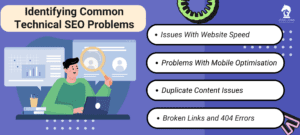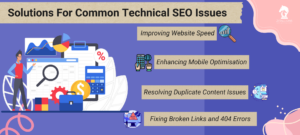Content
SHARE

Technical SEO is a vital part of optimising a website for better performance and search engine ranking. Unlike traditional SEO, which focuses on content and links, technical SEO ensures that a site’s infrastructure, speed, mobile-friendliness, and other technical factors are in top shape. Without addressing these underlying issues, other SEO efforts may fall short. In this article, we explore how to identify and fix common technical SEO problems, such as slow site speed, mobile optimisation, duplicate content, and broken links.

Understanding The Basics of Technical SEO
Technical SEO is essential in maintaining a healthy website and ensuring it ranks well in search engine results. Unlike traditional SEO, which focuses on content and link-building, technical SEO delves into the site architecture and performance. It addresses aspects that affect how search engines crawl and index a site. By understanding its principles, webmasters can optimise their websites for better visibility and user experience
What Is Technical SEO?
Technical SEO refers to the processes involved in optimising a website’s technical aspects to improve its positioning within search engine results.
It encompasses a variety of elements:
- Site Speed
- Mobile-Friendliness
- Indexing
- Crawlability,
- Structured data
- Security & etc.
By making these elements work harmoniously, webmasters significantly enhance their site’s performance. For instance, ensuring a mobile-friendly website is crucial, as more users access the internet via mobile devices than ever before. This improves user engagement and aligns with search engine algorithms that favour mobile-optimised sites.
Why is Technical SEO Important?
The importance of technical SEO cannot be overstated. It acts as the foundation upon which a successful SEO strategy is built. Without a technically sound website, all other SEO efforts lead to minimal results. Search engines, like Google, prioritise user experience, and a well-optimised website ensures users can navigate efficiently. Furthermore, addressing technical issues directly influences a site’s visibility, click-through and conversion rates.
For example, a slow-loading website can frustrate users, leading to higher bounce rates, which signals to search engines that the site may not provide a satisfactory user experience. Additionally, implementing structured data can enhance how search engines understand your content, potentially leading to rich snippets that attract more clicks.
Identifying Common Technical SEO Problems
Identifying common technical SEO problems is the first step in remedying potential issues. Many problems can hinder your site’s performance and ranking if left unchecked. Here we discuss some of the most prevalent technical issues that website owners encounter.
Issues With Website Speed
Website speed is a critical factor for user experience and SEO. Slow-loading websites frustrate users leading to high bounce rates. Google indicated that page speed is a ranking factor, which means if your site is sluggish, it could hinder your ranking efforts.
There are numerous causes for slow website performance:
- Excessive server response times, unoptimised images, and large scripts.
To enhance speed, website owners can employ techniques such as :
- Leveraging Browser Caching, Minimise HTTP Requests, and Content Delivery Networks (CDNs) to distribute content more efficiently.
Regularly testing your website’s speed with tools like Google PageSpeed Insights provides valuable insights into areas needing improvement.
Problems With Mobile Optimisation
With the increasing number of mobile users, having a mobile-optimised site is no longer optional, it’s essential. Google’s mobile-first indexing means that the mobile version of your website is considered the primary version during the indexing process. If your site isn’t responsive or mobile-friendly, it leads to poor user experiences and lower rankings in search results.
Mobile optimisation extends beyond just responsive design, it includes ensuring that buttons are easily clickable, text is legible without zooming, and the overall navigation is intuitive on smaller screens. With mobile traffic accounting for a significant portion of web visits, neglecting this aspect can severely limit your audience reach and engagement.
Duplicate Content Issues
Duplicate content refers to substantial blocks of content being identical or similar across multiple pages. This confuses search engines, leading to a struggle in determining which version to rank. Duplicate content can arise for various reasons, such as having different URLs for the same page or printing versions of content. Addressing duplicate content is vital, as it can dilute your site’s authority and impact your rankings.
Implementing canonical tags helps signal to search engines which version of the content should be prioritised. Additionally, conducting regular content audits assists in identifying and consolidating duplicate content, ensuring that your site maintains its credibility and authority in the eyes of search engines.
Broken Links and 404 Errors
Broken links and 404 errors significantly affect a website’s user experience and SEO performance. A broken link directs users to a non-existent page, leading to frustration and a potential loss of credibility. Regularly auditing your website to identify and fix these broken links is crucial to maintaining a functional site. Search engines consider user experience, so resolving these issues can positively impact your ranking.
Moreover, implementing custom 404 pages can help mitigate the negative effects of broken links by guiding users back to relevant content rather than leaving them stranded. This not only improves user experience but can also help retain visitors who might otherwise leave your site altogether.
How To Diagnose Technical SEO Issues
Diagnosing technical SEO issues can be approached through various methods, including using specialised tools or performing manual checks. Both approaches can provide valuable insights and help pinpoint areas of your site that require attention.
Using SEO Audit Tools
SEO audit tools are invaluable when trying to diagnose technical SEO issues. These tools can crawl your website and identify problems related to indexing, site speed, and mobile optimisation. Popular choices include Google Search Console, SEMrush, and Screaming Frog SEO Spider. These tools provide detailed reports, highlighting areas that need improvement and offering recommendations on how to resolve them.
Furthermore, many of these tools come with features that allow you to track changes over time, enabling you to see the impact of your adjustments and refine your strategies accordingly. This ongoing monitoring is crucial for maintaining a healthy website, as SEO is not a one-time task but an ongoing process that requires regular attention and updates.
Manual Checks For SEO Problems
In addition to automated tools, manual checks can help diagnose issues.
This includes:
- Checking page load speed using browser developer tools or Google PageSpeed Insights.
- Ensuring that your website is mobile-friendly by reviewing it on various devices.
- Manually verifying that all internal and external links work.
Combining manual methods with automated tools allows a comprehensive audit of your site’s health. Additionally, examining the structure of your URLs and ensuring that they are clean and descriptive can significantly enhance your site’s crawlability. It’s also beneficial to check for duplicate content, as this can confuse search engines and dilute your ranking potential. By being thorough in your manual checks, you can uncover hidden issues that automated tools may overlook, leading to a more robust SEO strategy.
Solutions For Common Technical SEO Issues
Once you’ve identified the technical SEO issues plaguing your site, implementing solutions is the next step. Here are some effective strategies to remedy common problems.
Improving Website Speed
Improving website speed requires a multi-faceted approach. Start by optimising images for the web, as large files can significantly impact load times. Compressing files and enabling browser caching can also improve speed. Additionally, consider using a content delivery network (CDN) to distribute the load across multiple servers, which can enhance performance for users around the world. Furthermore, minifying CSS and JavaScript files can reduce size, leading to quicker loading times. It’s also beneficial to regularly monitor your site’s speed using tools like Google PageSpeed Insights, which can provide actionable recommendations tailored to your website.
Enhancing Mobile Optimisation
To enhance mobile optimisation, ensure your site employs a responsive design that adapts to various screen sizes. Minimising the use of pop-ups, which obstruct content, is also advisable. Optimising touch elements such as buttons for ease of use on mobile devices can improve the user experience, ultimately aiding your SEO efforts. Additionally, implementing Accelerated Mobile Pages (AMP) delivers content more quickly on mobile devices. This framework allows for a streamlined version of your pages, improving load times and user engagement, which positively influences your search rankings.
Resolving Duplicate Content Issues
Resolving duplicate content issues can be achieved through several strategies. Using canonical tags can signal to search engines which version of a page should be prioritised for ranking. Ensuring that URL parameters don’t result in duplicate pages through consolidating or redirecting them, further mitigates this issue. Regularly auditing your content to maintain uniqueness will help uphold your site’s authority. It can also be prudent to create a comprehensive content strategy that focuses on original, high-quality material, thereby reducing the likelihood of unintentional duplication.
Engaging with your audience through unique insights or perspectives can not only enhance your content’s value but also foster a loyal readership.
Fixing Broken Links and 404 Errors
Fixing broken links and 404 errors involves regularly checking for any links that direct users to non-existent pages. Tools like Google Search Console can help identify these errors. Once discovered, it’s essential to either update the links to point to relevant pages or redirect users to similar content. By maintaining a healthy link structure, you ensure users enjoy a seamless navigation experience.
The implementation of a custom 404 error page that guides users back to relevant content or offers suggestions for navigating your site not only improves user experience but also retains visitors who might otherwise leave due to frustration. Regularly reviewing your internal linking strategy can help prevent future broken links, ensuring a robust and user-friendly website.
Conclusion
In conclusion, technical SEO is a critical component of any successful digital strategy, as it directly impacts a website’s performance, visibility, and user experience. By addressing common technical issues such as slow website speed, poor mobile optimisation, duplicate content, and broken links, webmasters can enhance their site’s functionality and ensure it aligns with search engine best practices. Regular audits using automated tools and manual checks are essential for identifying and resolving these issues.
Ultimately, a well-optimised website improves user engagement, boosts search rankings, and fosters better overall performance, making technical SEO an ongoing and indispensable part of website management.
Technical SEO Fixes FAQs
What are common technical SEO issues?
Common technical SEO issues include slow page load times, broken links, duplicate content, improper use of robots.txt files, and incorrect canonical tags.
How can you improve page load times for better SEO?
Improving page load times can be achieved by optimising image sizes, minimising HTTP requests, utilising browser caching, and choosing a reliable web hosting service.
What steps should be taken to fix broken links?
To fix broken links, regularly audit your website using tools like Google Search Console or Screaming Frog, identify any 404 errors, and correct the links or set up redirects to the appropriate pages.
How can duplicate content issues be resolved?
Resolve duplicate content issues by ensuring each page has unique content, setting up 301 redirects for duplicate pages, and correctly using the canonical tag to point search engines to the primary page.
What are the best practices for using robots.txt and canonical tags?
Best practices for robots.txt include disallowing search engines from indexing duplicate or irrelevant pages. For canonical tags, ensure they are correctly pointing to the preferred URL of a set of similar or duplicate pages to consolidate ranking signals.















